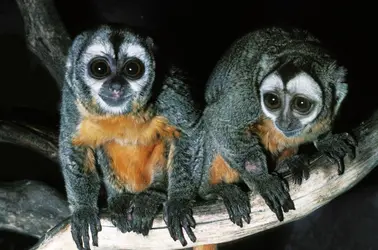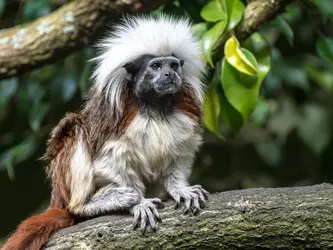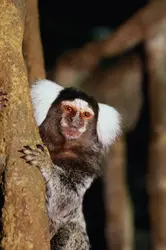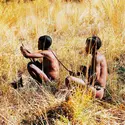- 1. Diagnose
- 2. Classification
- 3. Catégories systématiques (groupes zoologiques)
- 4. Habitat et comportement alimentaire
- 5. Biologie sexuelle et reproduction
- 6. Structures sociales
- 7. Dynamique des groupes sociaux
- 8. Ontogenèse
- 9. Socialisation des jeunes
- 10. Modes de communication
- 11. Processus cognitifs
- 12. La culture chez les primates non humains
- 13. Protection et conservation des Primates
- 14. Bibliographie
PRIMATES
Article modifié le
Bibliographie
J. Altmann, Baboon Mother and Infants, Harvard Univ. Press, Cambridge (Mass.), 1980
K. Benirschke, Primates : the Road to Self-Sustaining Populations, Springer-Verlag, New York, 1986
C. M. Berman, « Maternal Lineages as tools for understanding infant social development and social structure », in R. G. Rawling et M. J. Kessler dir., The Cayo Santiago Macaques : History, Behavior and Biology, State Univ. of New York Press, Albany, 1986
D. Bovet & B. L. Deputte « Matching vocalizations to faces of familiar conspecifics in grey-cheeked mangabeys », in Animal Cognition, 2006
S. Budiansky, If a Lion Could Talk, The Free Press, New York, 1998
D. Caillaud, F. Levréro, R. Cristescu, S. Gatti, M. Dewas, A. Gautier-Hion, M. Raymond, N. Ménard, « Spread of Ebola virus in a population of western lowland gorillas in Congo », in Current Biology, 2006
N. Chalmers, Social Behaviour in Primates, Edward Arnold, Londres, 1979
P. Charles-Dominique, Nocturnal Malagasy Primates : Ecology, Physiology and Behavior, Academic Press, San Diego (Calif.), 1980
S. Chevalier-Skolnikoff & F. E. Poirier, Primate Biosocial Development : Biological, Social and Ecological Determinants, Garland Publ. Inc., New York, 1977
T. H. Clutton-Brock, Primate Ecology : Studies of Feeding and Ranging Behaviour in Lemurs, Monkeys and Apes, Academic Press, Londres, 1977
A. Coimbra-Filho & R. A. Mittermeier, Ecology and Behavior of Neotropical Primates, vol. I, Academia Brasileira de Ciencias, Rio de Janeiro, 1981
B. L. Deputte, « L'Évitement de l'inceste chez les Primates », in La Recherche, no 193, 1987 ; « Structuration des comportements en fonction du sexe chez les primates », in A. Ducros et M. Panoff dir., La Frontière des sexes, P.U.F., Paris, 1995 ; « Primate socialization revisited : Theoretical and practical issues in Social Ontogeny », in Advances in the Study of Behavior, 29, 2000
B. L. Deputte, M. Busnel, N. Deshaies & S. Guyonnaud, « Recherches éthologiques au service d'un programme à vocation humanitaire : le cas du programme d'aide simienne aux personnes tétraplégiques (P.A.S.T.) », in C. Baudoin dir., L'Éthologie appliquée aujourd'hui, vol. 3 : Éthologie humaine. E.D. Éditions, Levallois-Perret, 2003
W. R. Dukelow & J. Erwin, Comparative Primate Biology, vol. 3 : Reproduction and Development, Alan R. Liss Inc., New York, 1986
R. I. M. Dunbar, Reproductive Decisions : an Economic Analysis of Gelada Baboon Social Strategies, Princeton Univ. Press, Princeton-New Jersey, 1984 ; Primate Social Systems, Cornell Univ. Press, 1987
R. I. M. Dunbar & E. P. Dunbar, Social Dynamics of Gelada Baboons, Contributions to Primatology, 6, Karger, Bâle, 1975
L. M. Fedigan, Primate Paradigms : Sex Roles and Social Bonds, Univ. of Chicago Press, New York, 1991
J. Fooden, « Taxonomy and evolution of the sinica group of macaques, 4 Species account of Macaca thibetana », in Fieldiana Zoologica, 17, 1983
S. Gatti, F. Levréro, N. Ménard & A. Gautier-Hion, « Population and group structure of western lowland gorillas (Gorilla gorilla gorilla) at Lokoué, Republic of Congo », in Am. J. Primatol, 63, 2004
J. P. Gautier & A. Gautier, « Communication in Old World Monkeys », in T. A. Sebeok dir., How Animals Communicate, Indiana Univ. Press, Bloomington (Ind.), 1977
J. P. Gautier & A. Gautier-Hion, « Les Associations polyspécifiques chez les Cercopithécidés du Gabon », in Terre et vie, 23, 1969
A. Gautier-Hion, F. Bourlière, J. P. Gautier & J. Kingdon, A Primate Radiation : Evolutionary Biology of the African Guenons, Cambridge Univ. Press, Cambridge, 1988
A. Gautier-Hion, J. P. Gautier & R. Quris, « Forest Structure and fruit availability as complementary factors influencing habitat use by a troop of monkeys (Cercopithecus cephus) », in Rev. Ecol. (Terre et vie), 35, 1981
N. Gomes Da Silva, & B. L. Deputte, « Visual individual recognition in arboreal mangabeys (Lophocebus a. albigena) : preliminary study », in Folia Primatol., 69, 1998
D. R. Griffin, The Question of Animal Awareness, The Rockefeller Univ. Press, New York, 1976
C. P. Groves, A Theory of Human and Primate Evolution, Oxford Univ. Press, 1991 ; « Phylogenetic and population systematics of the mangabeys (Primates, Cercopithecoidea) », in Primates, 19, 1978
A. H. Harcourt, « Strategies of emigration and transfer by primates with particular reference to gorillas », in Z. Tierpsychol., 48, 1978
R. Harre & V. Reynolds, The Meaning of Primate Signals, Maison des sciences de l'homme, Paris, 1984
P. Hershkovitz, Living New World Monkeys (Platyrrhini), with an Introduction to Primates, vol. I, Univ. of Chicago Press, Chicago, 1977
W. C. O. Hill, Evolutionary Biology of the Primates, Academic Press, Londres, 1972
R. A. Hinde, Animal Behaviour : a Synthesis of Ethology and Comparative Psychology, McGraw Hill, Londres, 1966
S. B. Hrdy, The Langurs of Abu : Female and Male Strategies of Reproduction, Harvard Univ. Press, Cambridge (Mass.), 1977
A. Jolly, The Evolution of Primate Behavior, 2e éd., MacMillan Publ. Co., New York, 1985
F. Levréro, S. Gatti, N. Ménard & A. Gautier-Hion, « Living in non-breeding groups : an alternative social strategy for maturing gorillas », in Am. J. Primatol, 68, 2006
P. Marler & R. Tenaza, « Signaling behavior of apes with special reference to vocalizations », in T. A. Sebeok dir., How Animals Communicate, Indiana Univ. Press, Bloomington (Ind.), 1977
R. D. Martin, A. F. Dixson & E.-J. Wickings, Paternity in Primates : Genetic Tests and Theories, symposium, Karger, 1992
N. Ménard, & M. Qarro, « Bark stripping and water availability : a comparative study between Moroccan and Algerian Barbary macaques (Macaca sylvanus) », in Rev. Ecol. (Terre et vie), 54, 1999
J. C. Mitani, « Gibbon song duets and intergroup spacing », in Behaviour, 92, 1985
G. Mitchell & J. Erwin, Comparative Primate Biology, vol. 2a : Behavior. Conservation and Ecology, Alan R. Liss Inc., New York, 1986 ; vol. 2b, Behavior. Cognition and Motivation, ibid., 1986
J. Moore, « Female transfer in primates », in Inter J. Primatol., 5, 1984
J. R. Napier, Primates and their Adaptations, Carolina Biological Supply Co., Burlington (N.C.), 3e éd. 1987
J. R. Napier & P. H. Napier, The Natural History of the Primates, British Museum, Londres, 1985
L. Parr, « Perceptual biases for multimodal cues in chimpanzee (Pan troglodytes) affect recognition », in Animal Cognition, 7, 2004
J.-J. Petter, Le Propre du singe, Fayard, Paris, 1984
F. E. Poirier, Primate Socialization, Random House, New York, 1972
J. I. Pollock, « The Song of the Indri (Indri indri, Primates : Lemuroidea) : natural history, form and function », in Int. J. Primatol., 7, 1986
D. J. Povinelli, K. E. Nelson & S. T. Boysen, « Inferences about guessing and knowing by chimpanzees (Pan troglodytes) », in Journal of Comparative Psychology, 104, 1990
D. J. Povinelli, K. A. Parks & M. A. Novak, « Do rhesus monkeys (Macaca mulatta) attribute knowledge and ignorance to others ? », in Journal of Comparative Psychology, 105, 1991
D. Premack & G. Woodruff, « Does the chimpanzee have a theory of mind ? », in The Behavioral and Brain Sciences, 3, 1978
H. D. Rijksen & E. Meijaard, Our Vanishing Relative. The Status of Wild Orang-Utans at the Close of the Twentieh Century, Kluwer Academic Press, Tropenbos, 1999
J.-J. Roeder & J. R. Anderson, Primates : recherches actuelles, Masson, Paris, 1990
W. M. S. Russell & R. L. Burch, The Principles of Human Experimental Technique, Methuen, Londres, 1959
B. B. Smuts, D. L. Cheney, R. M. Seyfarth, R. W. Wrangham & T. T. Struhsaker, Primate Societies, Chicago Univ. Press, Chicago, 1987
C. T. Snowdon, C. H. Brown & M. R. Petersen, Primate Communication, Cambridge Univ. Press, New York, 1982
H. D. Steklis & J. Erwin, Comparative Primate Biology, vol. 4 : Neurosciences, Alan R. Liss Inc., New York, 1986
T. T. Struhsaker, The Red Colobus, Univ. Press of Chicago, Chicago, 1975
D. R. Swindler, Dentition of Living Primates, Academic Press, New York, 1976
D. R. Swindler & J. Erwin, Comparative Primate Biology, vol. 1 : Systematics Evolution and Anatomy, Alan R. Liss Inc., 1986
D. M. Taub, Primate Paternalism, Van Nostrand Reinhold Co. Inc., New York, 1984
J. Terborgh, Five New World Primates : A Study in Comparative Ecology, Princeton Univ. Press, Princeton, 1983
D. Todt, P. Goedeking & D. Symmes, Primate Vocal Communication, Springer Verlag, Berlin, 1988
M. Tomasello, B. Hare & B. Agnetta, « Chimpanzees, Pan troglodytes, follow gaze direction geometrically » in Animal Behaviour, 58, 1999
H. Vallois, « Ordre des Primates (Primates Linné 1758) », in P. P. Grassé dir., Traité de zoologie : anatomie, systématique, biologie, t. XVII, fasc. II, Masson, Paris, 1955
J. Vauclair, L'Intelligence de l'animal, Seuil, Paris, 1992
J. Vauclair & B. L. Deputte, « Se représenter et dire le monde ; développement de l'intelligence et du langage ; similarités et différences entre primates humains et primates non humains », in P. Picq et Y. Coppens dir., Aux origines de l'humanité. Le propre de l'homme, vol. 2, chap. 7, Fayard, Paris, 2001
E. Visalberghi, « Tool-use in capuchin monkeys : the solution to a mystery ? », in Folia primatologica, 75
F. B. M. de Waal, De la réconciliation chez les Primates (Peacemaking among primates), Flammarion, Paris, 1992
A. Whiten, J. Goodall, W. C. McGrew, T. Nishida, V. Reynolds, Y. Sugiyama, C. Tutin, R. W. Wrangham & C. Boesch, « Chimpanzee cultures », in Nature, 399, 1999
J. H. Wolfheim, Primates of the World : Distribution, Abundance and Conservation, Univ. of Washington Press, Seattle, 1983
B. Wood, L. Martin & P. Andrews, Major Topics in Primate and Human Evolution, Cambridge Univ. Press, Cambridge, 1986.
Accédez à l'intégralité de nos articles
- Des contenus variés, complets et fiables
- Accessible sur tous les écrans
- Pas de publicité
Déjà abonné ? Se connecter
Écrit par
- Bertrand L. DEPUTTE : docteur en éthologie, docteur ès sciences, professeur à l'École nationale vétérinaire d'Alfort
Classification
Médias
Autres références
-
BABOUIN
- Écrit par Marie-Claude BOMSEL
- 414 mots
- 2 médias
Singe au corps puissant, caractérisé par un museau allongé et nu comme celui du chien, d'où leur autre nom commun de cynocéphale (signifiant « tête de chien »). Répartition géographique : Afrique centrale, Afrique du Sud et Arabie. Habitat : savanes, collines rocheuses et forêts. Classe : Mammifères...
-
CERCOPITHÈQUE
- Écrit par Marie-Claude BOMSEL
- 436 mots
Singe de taille moyenne, au corps svelte et à longue queue non préhensile, vivant dans les forêts africaines, au sud du Sahara. Classe : Mammifères ; ordre : Primates ; famille : Cercopithécidés.
Autrefois appelés « guenons », les cercopithèques, représentés par plus de vingt espèces,...
-
CHASSEURS-CUEILLEURS (archéologie)
- Écrit par Jean-Paul DEMOULE
- 4 728 mots
- 3 médias
-
CHIMPANZÉ
- Écrit par Marie-Claude BOMSEL
- 639 mots
- 1 média
- Afficher les 28 références
Voir aussi
- MIMIQUE
- FÉCONDITÉ
- MONOGAMIE ANIMALE
- DÉVELOPPEMENT ANIMAL ou ONTOGENÈSE ANIMALE
- ESPRIT THÉORIE DE L'
- GLANDES
- PLACENTAIRES ou EUTHÉRIENS
- NEUROCRÂNE
- CYCLE ŒSTRAL
- SEXUEL COMPORTEMENT
- PLANTIGRADES
- PROSIMIENS
- LEMURIDAE ou LÉMURIDÉS
- INDRIDAE ou INDRIIDAE
- DAUBENTONIIDAE
- LORISIDÉS
- TARSIERS
- SINGES
- PLATYRHINIENS ou PLATYRRHINII
- CATARHINIENS ou CATARRHINII
- ANIMAL LANGAGE
- RÉPARTITION DES FLORES & DES FAUNES
- SIMIENS ou ANTHROPOIDEA
- ŒSTRUS
- EXTINCTION ou DISPARITION DES ESPÈCES
- CHEIROGALEIDAE
- GALAGIDAE
- ATÉLINÉS
- COLOBINÉS
- GROUPEMENTS ANIMAUX
- ANIMAL RÈGNE
- ANATOMIE ANIMALE
- POIL
- ONGLE
- PONGIDÉS ou PONGIDAE
- ODORANTES GLANDES
- ACCOUPLEMENT
- ANTHROPOMORPHES
- HYLOBATIDÉS ou HYLOBATIDAE
- ENVIRONNEMENT, droit et politique
- ATTACHEMENT THÉORIE DE L'
- ANTHROPISATION
- MÈRE-ENFANT RELATION
- POPULATIONS ANIMALES & VÉGÉTALES
- GESTATION
- HERBIVORES
- DOIGTS, zoologie
- CHANT, éthologie
- COMMUNICATION ANIMALE
- BIODÉMOGRAPHIE
- STÉRÉOTYPES COMPORTEMENTAUX
- MARQUAGE DU TERRITOIRE, éthologie
- ALARME, éthologie
- ATTRACTION, éthologie
- LÉMURIFORMES
- STREPSIRHINES
- HAPLORHINES
- CERCOPITHÉCOÏDES
- CERCOPITHÉCINÉS ou CERCOPITHÉCIDÉS
- GELADAS
- HOMINOÏDES
- PITHÉCINÉS
- RHINARIUM
- ATÉLIDÉS
- LORISIFORMES
- MEGALAPIDAE
- AYE-AYE
- ATÈLES
- CALLIMICO
- CALLITHRICIDÉS
- CÉBIDÉS
- MURIQUIS
- SAQUIS
- OUAKARIS
- MANGABEY
- NASIQUE
- PROTECTION ou CONSERVATION DES ESPÈCES
- ANIMAUX SAUVAGES EXPLOITATION DES







